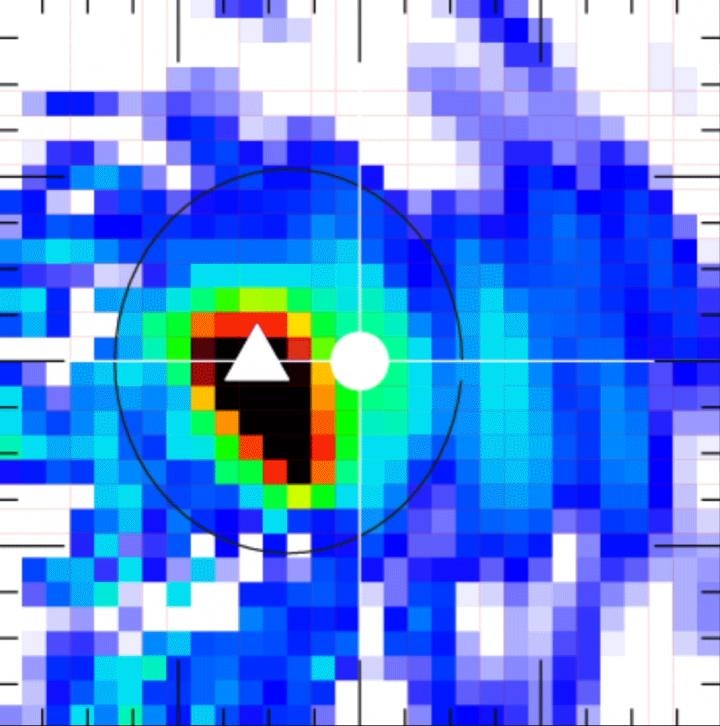Aug 12 2019
Spending four years and employing high-resolution instruments, the Magnetospheric Multiscale mission (MMS) has recently observed what no other spacecraft has—the first high-resolution measurements of an interplanetary shock.
 Data from the Fast Plasma Investigation aboard MMS shows the shock and reflected ions as they washed over MMS. The colors represent the amount of ions seen with warmer colors indicating higher numbers of ions. The reflected ions (yellow band that appears just above the middle of the figure) show up midway through the animation, and can be seen increasing in intensity (warmer colors) as they pass MMS, shown as a white dot. (Image credit: Ian Cohen)
Data from the Fast Plasma Investigation aboard MMS shows the shock and reflected ions as they washed over MMS. The colors represent the amount of ions seen with warmer colors indicating higher numbers of ions. The reflected ions (yellow band that appears just above the middle of the figure) show up midway through the animation, and can be seen increasing in intensity (warmer colors) as they pass MMS, shown as a white dot. (Image credit: Ian Cohen)
The Sun launches these shocks, which are composed of electromagnetic waves and particles. The shocks offer the perfect testbeds for gaining insights into larger universal phenomena. However, to measure the interplanetary shocks, it is necessary to be at the right spot at the right time. How the MMS spacecraft could exactly do that has been explained below.
What’s in a Shock?
In interplanetary shocks, which are a kind of collisionless shock, particles transmit energy via electromagnetic fields rather than directly bumping into one another. Such collisionless shocks can be observed across the universe, including in black holes, distant stars, and supernovae. MMS analyzes collisionless shocks around Earth to gain deeper insights into the shocks throughout the universe.
The Sun is the starting place for the interplanetary shocks since it continuously emits streams of charged particles known as the solar wind.
In general, the solar wind is of two types—fast and slow. A shock wave is created when a fast solar wind stream overtakes a slower one, quite similar to how a boat moving through a river creates a wave. Then, the wave spreads out throughout the solar system. On January 8th, 2018, MMS was in just the apt place to observe one interplanetary shock as it occurred.
Catching the Shock
The unmatched fast and high-resolution instruments of the MMS enabled the measurement of the shock. The Fast Plasma Investigation is one such instrument equipped in the MMS. This series of instruments have the ability to measure electrons and ions surrounding the spacecraft at nearly six times in a second. As the accelerating shock waves can pass the spacecraft within half a second, the high-speed sampling is vital to capturing the shock.
The researchers investigated the data from January 8th and found a cluster of ions from the solar wind. Soon after, they observed a second ion cluster, formed by ions already in the area that had bounced off the shock as it passed by. Analysis of the second cluster offered evidence to support an energy transfer theory first proposed in the 1980s.
Four identical spacecraft aboard MMS fly in a tight formation that enables 3D mapping of space. At the time of the shock, the four MMS spacecraft were separated by just 12 miles (in contrast to the previous spacecraft that had been separated by hundreds of kilometers). This enabled the researchers to also observe small-scale uneven patterns in the shock. Recently, the event and results were reported in the Journal of Geophysical Research.
Going Back for More
Owing to timing of the orbit and instruments, MMS is in position to observe interplanetary shocks only about once a week. However, the researchers believe they can find more. Specifically now, following the observation of a strong interplanetary shock, MMS researchers hope to be able to find weaker ones that are quite rarer and less well understood. Spotting a weaker event could pave the way to a new scheme of shock physics.
Animation of Solar Wind
Animation of the solar wind. (Image credit: NASA's Goddard Space Flight Center/Conceptual Image Lab)